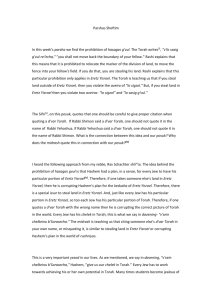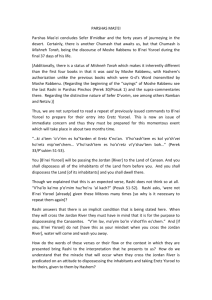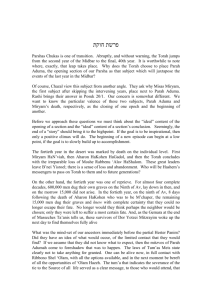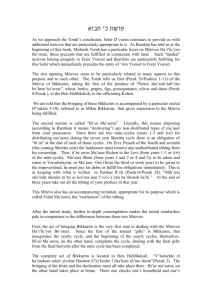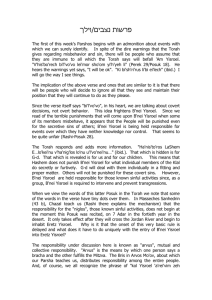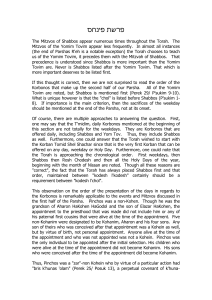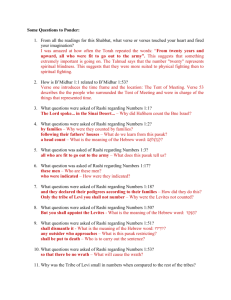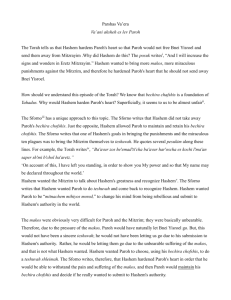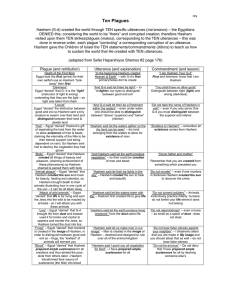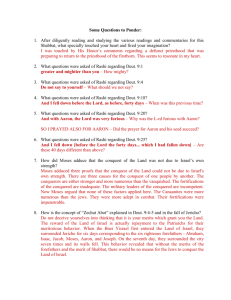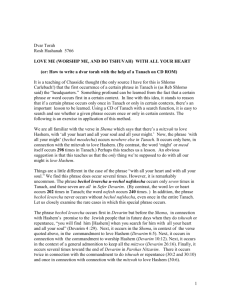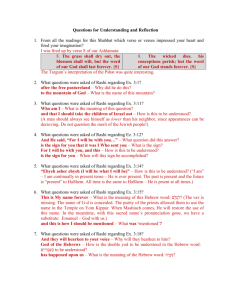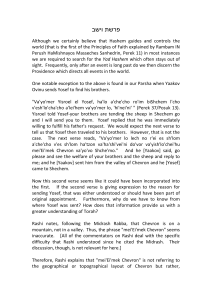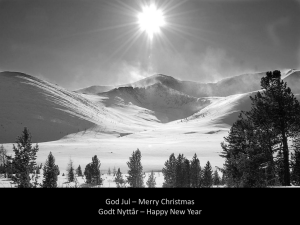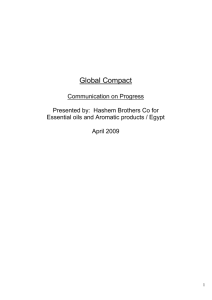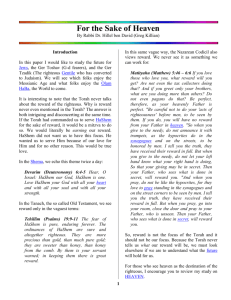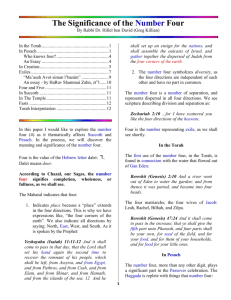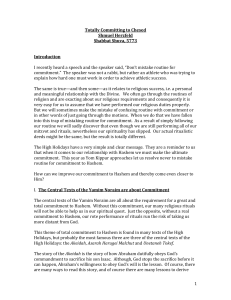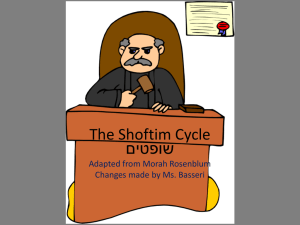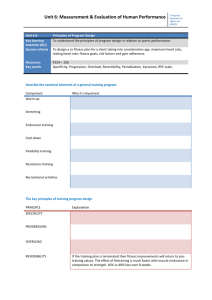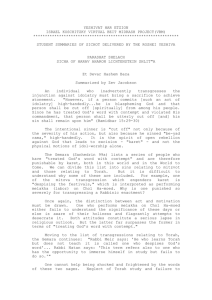Parshas Behar - Mesivta N`eimus HaTorah
advertisement
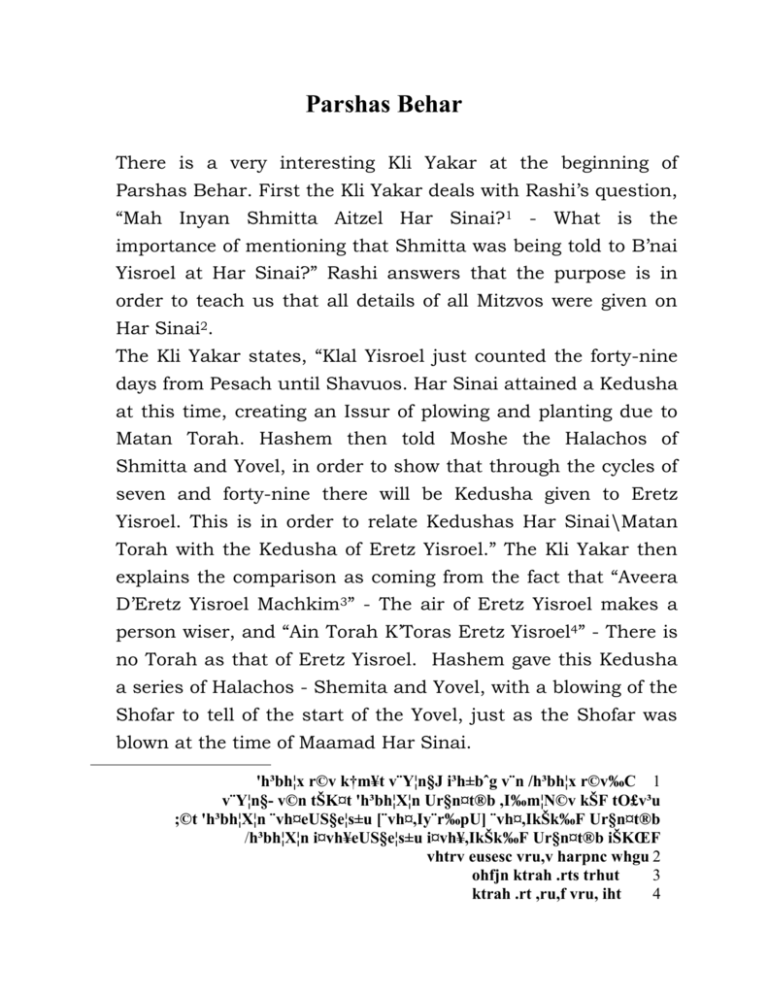
Parshas Behar There is a very interesting Kli Yakar at the beginning of Parshas Behar. First the Kli Yakar deals with Rashi’s question, “Mah Inyan Shmitta Aitzel Har Sinai?1 - What is the importance of mentioning that Shmitta was being told to B’nai Yisroel at Har Sinai?” Rashi answers that the purpose is in order to teach us that all details of all Mitzvos were given on Har Sinai2. The Kli Yakar states, “Klal Yisroel just counted the forty-nine days from Pesach until Shavuos. Har Sinai attained a Kedusha at this time, creating an Issur of plowing and planting due to Matan Torah. Hashem then told Moshe the Halachos of Shmitta and Yovel, in order to show that through the cycles of seven and forty-nine there will be Kedusha given to Eretz Yisroel. This is in order to relate Kedushas Har Sinai\Matan Torah with the Kedusha of Eretz Yisroel.” The Kli Yakar then explains the comparison as coming from the fact that “Aveera D’Eretz Yisroel Machkim3” - The air of Eretz Yisroel makes a person wiser, and “Ain Torah K’Toras Eretz Yisroel4” - There is no Torah as that of Eretz Yisroel. Hashem gave this Kedusha a series of Halachos - Shemita and Yovel, with a blowing of the Shofar to tell of the start of the Yovel, just as the Shofar was blown at the time of Maamad Har Sinai. 'h³bh¦x r©v k†m¥t v¨Y¦n§J i³h±bˆg v¨n /h³bh¦x r©v‰C 1 v¨Y¦n§­ v©n tŠK¤t 'h³bh¦X¦n Ur§n¤t®b ,I‰m¦N©v kŠF tO£v³u ;©t 'h³bh¦X¦n ¨vh¤eUS§e¦s±u [¨vh¤,Iy¨r‰pU] ¨vh¤,IkŠk‰F Ur§n¤t®b /h³bh¦X¦n i¤vh¥eUS§e¦s±u i¤vh¥,IkŠk‰F Ur§n¤t®b iŠKŒF vhtrv eusesc vru,v harpnc whgu 2 ohfjn ktrah .rts trhut 3 ktrah .rt ,ru,f vru, iht 4 The Kli Yakar then quotes other reasons for the Halachos of Shmitta and Yovel. At first he quotes those who say that it relates to agricultural practice. One should learn to leave an area barren every seventh year in order to strengthen the ability of the land to produce in the years that it is planted. The Kli Yakar asks a number of questions on this explanation. One question is that we find that when Klal Yisroel doesn’t keep Shmitta, it causes a Chiyuv Galus. Why Galus? Let the punishment be that the land doesn’t produce. Even if the punishment should be Galus, what will be gained by sending Klal Yisroel to Galus and having Goyim live in Eretz Yisroel, who will not keep Shmitta either? Furthermore, this should not be called Shabbos LaHashem but Shabbos LaAretz - a rest for the land. The Kli Yakar then quotes those who explain that Shmitta is a way to remember that Hashem created the world. The Kli Yakar asks, we know that Shabbos is for this purpose. If Shabbos, which comes weekly, doesn’t help us remember that Hashem created the world, how will Shmitta accomplish our remembering it when it only comes once in seven years? The Kli Yakar then explains that the purpose of Shmitta and Yovel are to instill Emuna and Bitachon in Hashem. Hashem stated that Klal Yisroel should veer from the accepted agricultural practice. The accepted practice is that a person plants two thirds of his land each year, rotating which part is left barren. In this way each part of land is planted two out of three years. Klal Yisroel are told to plant their entire property for six straight years and then the seventh year it should all be left alone. Not only is the land used more, the Torah says that if you keep Shmitta, the sixth year’s produce will last for three years! This clearly is not natural, but a Ness. The Kli Yakar adds that the Passuk says “V’Asas Es Hatevuah Lishlosh Hashonim5” - And it will make the produce for three years.” The land doesn’t produce three times the crops, but the same amount of crops as usual. Hashem places a Brocha in the food that it is three times as satisfying and therefore, lasts three years. In this way the message of Emuna and Bitachon in Hashem is strengthened. Therefore, the punishment for not keeping Shmitta is the lack of Emuna in Hashem. People must learn to realize that the land isn’t ours - it is Hashem’s. We are supported by Hashem through the Brocha that is given to the produce which Hashem allows to grow due to our “Hishtadlus6” - efforts. When we do not learn this lesson, and we do not keep Shmitta, we are acting as if we control and determine the use of the land. The land, which wants the Zechus of our keeping Shmitta and teaching this lesson, will then “spit out the people.7” The nations that will take over the land are not causing the land pain since they are governed anyway by the laws of nature. Is there a lesson or connection between what the Kli Yakar began with and this explanation? It may be possible that the connection is as follows: The first part of the Kli Yakar is saying that the Torah connected Shmitta and Yovel to Har Sinai in order that we recognize the :ohœ°b¨­©v J«¼k§Jˆk vº¨tUc§T©v›,¤t ¿,¨GŠg±u 5 ,uks,av 6 of,t .rtv the, tk" trev iuakn 7 v,ut oftnyc relationship between Kabolas HaTorah and Kedushas HaAretz. We also must realize that this Kedushas HaAretz has a special Havtacha8 - promise, “Ainai Hashem Elokecha Bah9 - the eyes of Hashem are upon the land.” All that happens with Eretz Yisroel is related to what Hashem sees as being required and needed. Hashgochas Hashem (a part of Emuna and Bitachon) is to view the world with an eye of the Torah guiding us. This comes from seeing Kedushas HaTorah. Seeing that Hashem says, “Hagbail Es Hahar V’Kidashto10” - lift the mountain and make it holy.” The Kedushas HaTorah lifts, and our recognition of the special Hashgacha of Hashem on Eretz Yisroel is a strength in our Emuna. May we merit strengthening our recognition of Torah and Emunas Hashem. vjycv 8 ///vc lhekt ws hbhg 9 u,aseu rvv ,t kcdv 10
